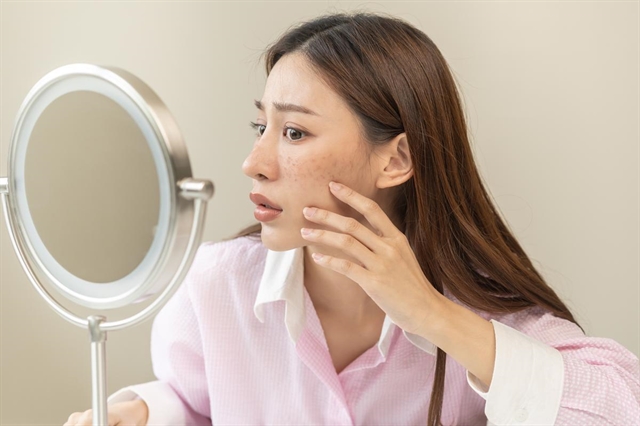 Life & Style
Life & Style

 |
| Dr. Snigdha Singh. Photo courtesy of Family Medical Practice |
Dr. Snigdha Singh*
Melasma is a common skin condition that causes brown or grey patches to develop on the skin, usually on the face. It is more common in women than men and is often associated with hormonal changes, such as pregnancy or the use of birth control pills. In this article, we will discuss the various factors that can be responsible for causing melasma and the multiple treatment modalities available.
Understanding the Factors Responsible for Melasma
The exact cause of melasma is not fully understood, but there are several factors that can contribute to its development. These include:
1. Hormonal Changes: Melasma is often associated with hormonal changes, such as pregnancy or the use of birth control pills. This is because these changes can stimulate the production of melanin, the pigment that gives color to the skin.
2. Sun Exposure: Sun exposure is a major factor in the development of melasma. The UV rays from the sun can stimulate the production of melanin, which can lead to the development of dark patches on the skin.
3. Genetics: There is a genetic component to melasma, as it tends to run in families. If you have a family member with melasma, you may be at an increased risk of developing it yourself.
4. Skin Type: People with darker skin types are more prone to developing melasma, as they have more melanin in their skin.
 |
| People with darker skin types are more prone to developing melasma, as they have more melanin in their skin. Photo shutterstock.com |
Multiple Treatment Modalities for Melasma
There are several treatment modalities available for melasma, including:
1. Topical Treatments: Topical treatments, such as hydroquinone, tretinoin, and corticosteroids, can be effective in reducing the appearance of melasma. These treatments work by inhibiting the production of melanin and promoting cell turnover.
2. Chemical Peels: Chemical peels involve the application of a chemical solution to the skin, which causes the outer layer of skin to peel off. This can help to lighten the patch by removing the excess pigment from the skin.
3. Microdermabrasion: Microdermabrasion involves the use of a device to exfoliate the outer layer of the skin. Its mechanism of action is by removing the excess pigment from the skin.
4. Vampire Facial: It is a procedure that includes Microneedling and Platelet Rich Plasma therapy. Microneedling makes tiny wounds in the skin that allows topical treatments to go deeper and stimulates collagen production. The growth factors in PRP help speed the healing process. So, you can improve your melasma, reduce your wrinkles and improve the texture and tone of your skin in one go.
5. Laser Therapy: Laser therapy involves the use of a laser, most commonly low-fluence Q-switch Nd-Yag laser to target the excess pigment in the skin. This can help to reduce the appearance of melasma by breaking up the excess pigment.
6. Sun Protection: Sun protection is an important part of managing melasma. This includes wearing protective clothing, such as hats and long-sleeved shirts, and using a broad-spectrum sunscreen with an SPF of 30 or higher.
7. Lifestyle Changes: Certain lifestyle changes, such as avoiding the use of birth control pills or hormonal therapies, adding antioxidants to your diet can help to reduce the risk of developing it.
8. Home Remedies: Some people have found that home remedies, such as applying a mixture of lemon juice and honey to the affected areas, can be effective. Vitamin C, Vitamin E and tea tree oil play a supplementary role in the treatment. However, it is important to speak with your dermatologist before trying any home remedies, as they may not be safe or effective for everyone.
With diligence and time, melasma can be significantly improved or resolved. The trickiest aspect of this condition are flare-ups that might happen in many cases even after complete remission. So, once remission is achieved, taking preventive measures is the key. So, with strict sun protection, adding antioxidants to your diet, following a specific skincare routine with the desired activities along with the suggested treatment plan, you can take on your melasma. Family Medical Practice
* Dr. Snigdha Singh studied a Bachelor of Medicine and Surgery and a masters in Dermatology. She specialises in diagnosing and treating a wide variety of skin disorders for both adults and children. She can also advise on numerous skin cosmetic conditions and treating benign skin disorders by RF cautery, Cryosurgery and minor surgery as indicated.
Visit Family Medical Practice Hanoi 24/7 at 298I P. Kim Mã, Kim Mã, Ba Đình. To book an appointment, please call us at (024).3843.0784, or contact us via Whatsapp, Viber or Zalo on +84.944.43.1919 or email hanoi@vietnammedicalpractice.com.
FMP’s downtown location in Hồ Chí Minh is in Diamond Plaza, 34 Đ. Lê Duẩn, Bến Nghé, District 1, and 95 Đ. Thảo Điền, District 2. Tel. (028) 3822 7848 or email hcmc@vietnammedicalpractice.com.




